Fire bricks or refractory bricks are block of refractory ceramic material used in furnaces, kilns and fireboxes.
They are primarily built to resist excessive temperatures, usually have to decrease thermal conductivity for higher power efficiency.
Here we will learn about fire bricks, types of fire bricks, advantages & disadvantages of refractory bricks.
Introduction to Fire Bricks:
Fire bricks can preserve excessive heat without melting or fusion, usually consists of silicon dioxide and aluminium oxide.
The process involved in the manufacturing of firebricks at high temperatures to attain the specified results.
Typically, dense fire brick are used with excessive mechanical, chemical, or thermal stresses such as friction, wooden, or ash inside a furnace manufactured from wood for high-temperature diffusion.
Properties of fire brick:
- Fire brick is yellow-white or white in colour.
- The standard brick size varies from 9 X 4.5 X 2.5 inches to 9 X 2.75 X 2.25 inches.
- A typical fire brick weighs about 30 to 35 N.
- The compressive strength of fire brick ranges from 200 to 220 kg / cm2.
- The water absorption ratio is 5 to 10%.
Types of fire bricks:
Fire brick are broadly classified into three types:
1. Acidic Fire Bricks:
Acidic fire brick often referred to as acid-resistant brick, are especially used to withstand weathering chemical substances or acidic actions.
Generally, a traditional brick made of natural fire clay is nearly as good as a brick, but when more acid resistance is required, a further amount of silica is added to the fire clay, which increases its composition, up to 97%.
Acid bricks are burnt at high temperatures for a very long time.
2. Basic Fire Bricks:
They are good for corrosion resistance and chemical resistance.
They contain high quantities of magnesia, lime can be used as a bonding material.
This bricks are magnetite bricks, magnesia-carbon, magnesia-chrome bricks, and many others.
3. Neutral Fire Bricks:
These are good in both acidic and basic lining functions.
They present good resistance to acidic fumes as well as corrosive actions.
Neutral bricks are of two types, namely, alumina bricks and chromite bricks.
High alumina bricks include large amounts of alumina while chromite bricks include chromium, iron oxide, silica, iron ore and bauxite in variable proportions.

Advantages of fire clay bricks:
- Fire clay brick is environmentally friendly.
- These bricks are fireproof and heat insulation.
- They are very inexpensive and very durable.
- Also, has a good moisture-proof function.
Disadvantages of refractory bricks:
- Clay brick is made of concrete and they are much heavier than other masonry materials.
- The soundproofing effect of clay brick is poor.
- The main raw material of clay brick is clay and it will harm the environment.
Use of fire bricks:
Fire brick is used for the following purposes as follow:
- They are used for lining the inner floor of kilns, furnaces, chimneys, and many others.
- To construct fire-resistant structures in order to reduce structural damage to fire accidents.
- For the inner lining of an oven made from wood.
- Due to their low thermal conductivity, ovens is used as insulating material for furnaces.
Also read: Sand Lime Bricks, Fly ash Bricks & Clay Bricks
Conclusion:
Refractory bricks are primarily built to withstand the high temperatures but will typically have lower thermal conductivity for greater energy efficiency.










It’s great that you mentioned that Acidic fire brick or acid-resistant brick are especially used to withstand weathering chemical substances or acidic actions. My dad’s garage floor started weathering due to oil and car fluids damaging it. I’ll share this with him later at dinner. Thank you.